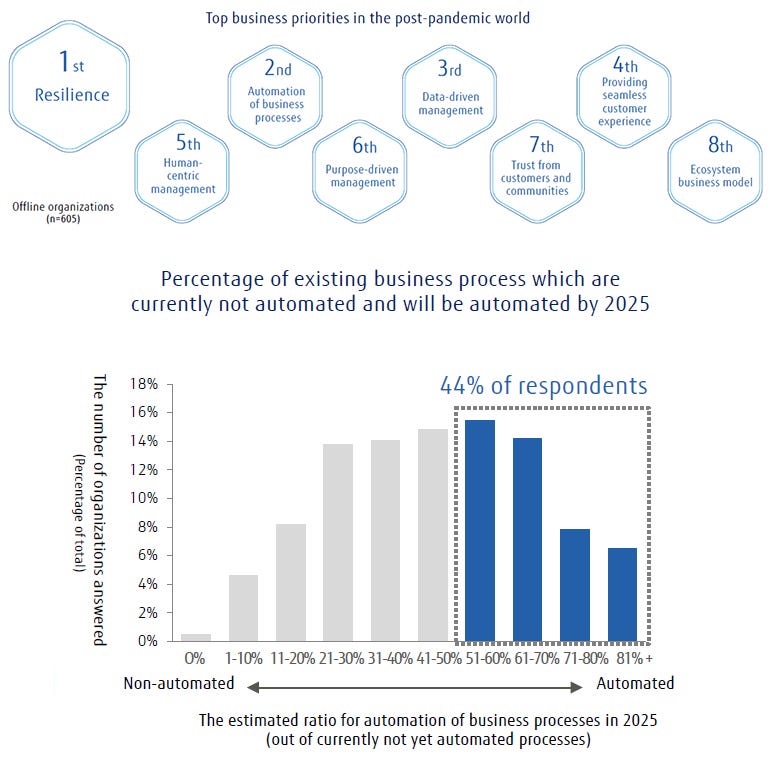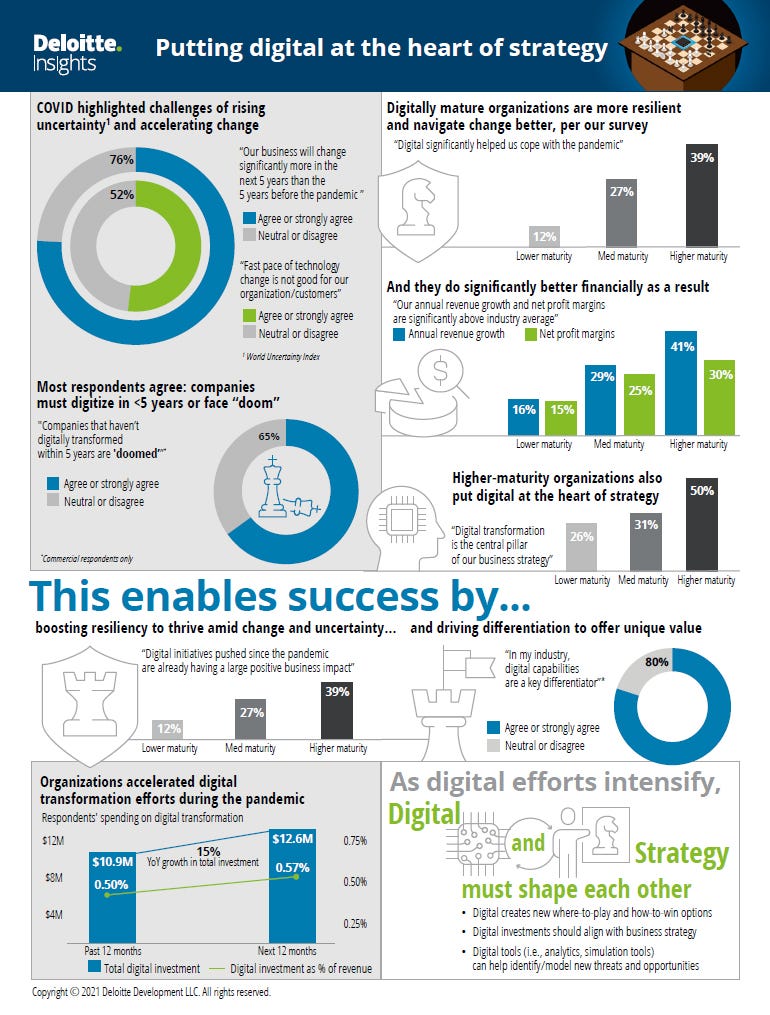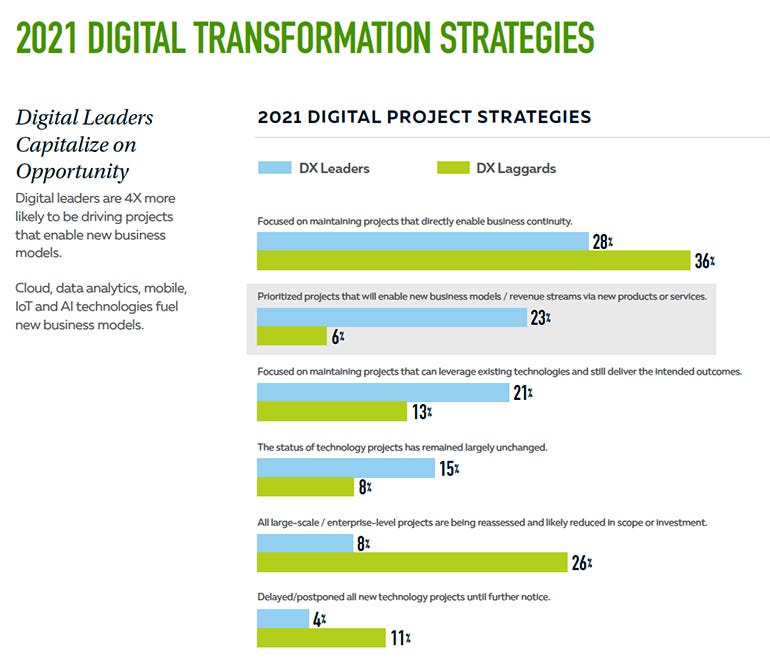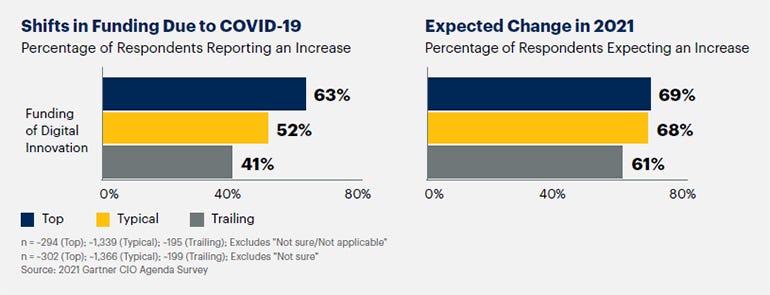![]()
Charles McLellan
| October 1, 2021
| Topic: Digital Transformation: A CXO’s Guide

Can we cope with accelerating digital transformation?
Watch Now
In ZDNet’s recent Tech Budgets 2022 special report, we noted how digital transformation has helped companies become more flexible and resilient in the face of worldwide recession, leaving the more digitally mature among them better placed to prosper in the post-pandemic era.
For the next instalment, tune into IDC’s 2022 DX predictions webcast on 28 October.
Let’s see how these predictions are working out in practice.
What the surveys reported
Many surveys take the temperature of digital transformation each year, covering a mix of organization sizes, sectors and geographies. Here’s a roundup of some key reports, the most recent of which give some pointers to the post-pandemic future.
|
Survey |
Author / sponsor |
Survey period |
Respondents |
|
Global Digital Transformation Survey Report 2021: Priorities in the post-pandemic world (August 2021) |
Fujitsu Future Insights |
February 2021 |
1,200 CxOs and decision-makers at large and mid-sized organizations spread across 9 countries worldwide |
Key findings
Strengthen digital muscles to build resilience Reimagine the way people and technology work together Design seamless customer experiences that cover both online and offline Improve employee well-being Align business goals with societal goals
By ‘digital muscles’, Fujitsu Future Insights (FFI) is referring to six organizational capabilities: Leadership (digital transformation is the priority of the CEO); Ecosystem (establishing a trusted ecosystem of partners); Empowered people (ensuring people have the right skills and opportunities to grow); A culture of agility (an innovation-supporting culture with an appetite for change); Value from data (the ability to use trusted data to deliver outcomes, while keeping it secure); and Business integration (enabling technology to become the business operating system).
These capabilities, FFI says, have helped organizations respond to the pandemic effectively. Here are the top post-pandemic business priorities revealed by the FFI survey, plus a significant finding relating to business process automation:

Images: Global Digital Transformation Survey Report 2021: Priorities in the post-pandemic world (Fujitsu Future insights, 2021)
On the face of it, the above chart simply demonstrates business leaders’ strong appetite for automation: 44% of organisations will have automated more than half of their currently non-automated processes by 2025. However, FFI sees this as evidence for radical transformation over the next four or five years:
We think organizations should reimagine a new, balanced way people and technology work together. How can organizations maximize the potential and well-being of their people, while increasing productivity through automation. Definitely, ethics and trust are becoming more important than ever before in redesigning future business processes.
|
Survey |
Author / sponsor |
Survey period |
Respondents |
|
2021 Deloitte Digital Transformation Executive Survey: Putting digital at the heart of strategy (April 2021) |
Deloitte Insights |
November 2020 (US), January/February 2021 (EMEA, APAC) |
2,860 executives across industries in US (56%), EMEA (25%) and APAC (19%) |
Key findings
Digital possibilities must shape strategy Digital helps organizations thrive amid uncertainty and change Digital enables new ways to differentiate All strategy must be digital strategy Digital transformation is a journey that never ends
Deloitte Insights has helpfully summarised its survey results in this infographic:

Source: 2021 Deloitte Digital Transformation Executive Survey: Putting digital at the heart of strategy (April 2021)
Deloitte’s survey highlights the value of digital transformation very clearly. Digitally mature organizations are more likely to agree that: “Digital significantly helped us cope with the pandemic”; that “Our annual revenue growth and net profit margins are significantly above industry average”; and that “Digital transformation is the central pillar of our business strategy”.
|
Survey |
Author / sponsor |
Survey period |
Respondents |
|
2021 State of Digital Transformation: Building a Framework for Digital Success (March 2021) |
TEKsystems |
November 2020 |
430 technology and business decision-makers in enterprise IT and line-of-business functions across a broad spectrum of industries |
Key findings
Mind the gaps. Technology deployed during the pandemic may not be compliant with privacy and security policies or may not be integrated with other systems.Secure consensus and conviction among senior leaders regarding digital transformation goals. Utilize that alignment to break down organizational silos. Cultivate a culture that embraces change and agility. Identifying the right metrics and making data-driven decisions are critical to digital transformation success. Accept and leverage differences to create growth and opportunities. Build an inclusive environment that allows your employees and your company to flourish and succeed. Identify the skills and expertise required to execute digital transformation efforts and determine how workforce models should be aligned to digital business. Implement the right technologies that will achieve the desired outcomes and think about how they can be scaled across the enterprise.
TEKsystems divided its survey population into digital leaders and digital laggards. DX leaders have “a mature digital transformation plan where digital processes and mindsets are ingrained in the DNA of the organization”, while DX laggards have “tentative plans and limited digital transformation initiatives and investments in place”. Among the characteristics of DX leaders is a greater (4X) likelihood of driving projects that enable new business models:

Image: 2021 State of Digital Transformation: Building a Framework for Digital Success (TEKsystems, 2021)
|
Survey |
Author / sponsor |
Survey period |
Respondents |
|
The 2021 CIO Agenda: Seize This Opportunity for Digital Business Acceleration (Dec 2020) |
Gartner |
2020 |
1,877 CIOs across 74 countries (33% North America, 37% EMEA, 22% APAC, 9% Latin America) |
Key findings
CIOs have the opportunity to play a leading role in digital business accelerationRedirect resources: Direct more investment and people toward new business prioritiesRemodel operations: Revamp business operations to increase efficiency and supply chain resilienceWin differently: Go where customers areRefocus IT leadership: Center on digital business acceleration
Regarding the top-level finding, ‘CIOs have the opportunity to play a leading role in digital business acceleration’, Gartner had this to say:
During the COVID-19 lockdown, many CIOs helped save their enterprises. They now have the attention of the CEO in a way they hadn’t before. The enterprise’s path to the future runs through IT, and boards and CEOs know it…These stronger relationships give CIOs leverage they’ll need for their next big challenge – digital business acceleration.
Gartner divided its 1,877 survey sample into top-performing (303), typical (1,373) and trailing (201) organizations, based on a combination of their digital maturity, business performance and pandemic response. The analyst firm found that although tech spending will increase across the board for most IT organizations in 2021, top performers got in early during 2020, boosting their competitive position:

Image: The 2021 CIO Agenda: Seize This Opportunity for Digital Business Acceleration (Gartner, 2020)
Gartner found that organisations that have already increased their funding of digital innovation are 2.7 times more likely to be top performers than trailing performers.
Outlook
Digitization has proved its worth during the pandemic, with more digitally mature businesses generally proving resilient in the face of serious disruption.
Going forward, businesses will need to adapt to the post-pandemic landscape as widespread hybrid working changes the way employees and customers interact with them. And rather than reacting to events, businesses will need detailed roadmaps that set out how they will digitize their business processes to achieve current and future goals. The efficiency, resilience and sustainability of supply chains should be a key element of these plans.
It won’t all be plain sailing, of course. In a recent survey of 500 decision-makers at large organizations in the UK, Citrix reported that 44% of IT leaders have had their “fingers burnt” by negative experiences with previous digital transformation programmes. In contrast, 51% cited at least one DX project that didn’t go according to plan. As a result, 85% say their past experiences have impacted their approach to current programmes, with 58% reporting ‘somewhat challenging’ experiences to date. Almost all (94%) embarked on their first DX programme with confidence in its outcome.
Still, 35% of CIOs and 41% of CTOs report ‘ideal’ experiences with digital transformation, 97% of IT leaders believe that their DX programmes are crucial to the success of their current role and future career, and 68% see major initiatives as a career-defining opportunity. IT leaders are also almost unanimous (99%) that digital transformation will be an important part of their businesses’ survival and future roadmap.
Clearly, there’s a lot to play for as digital transformation enters the post-pandemic phase.
Digital transformation
3 ways SMBs use machine learning to power digital transformation
Overnight digital transformation: Welcome to the year 2025, 60 months early
Digital transformation: Legacy technology, lack of skills, and funding are holding back NHS plans
After the remote working rush, here comes the CIO’s next challenge
What is digital transformation? Everything you need to know
Digital transformation: It’s time to invent the future we want (TechRepublic)
Related Topics:
CXO
Innovation
Digital Transformation: A CXOs Guide
Big Data Analytics
![]()
Charles McLellan
| October 1, 2021
| Topic: Digital Transformation: A CXO’s Guide